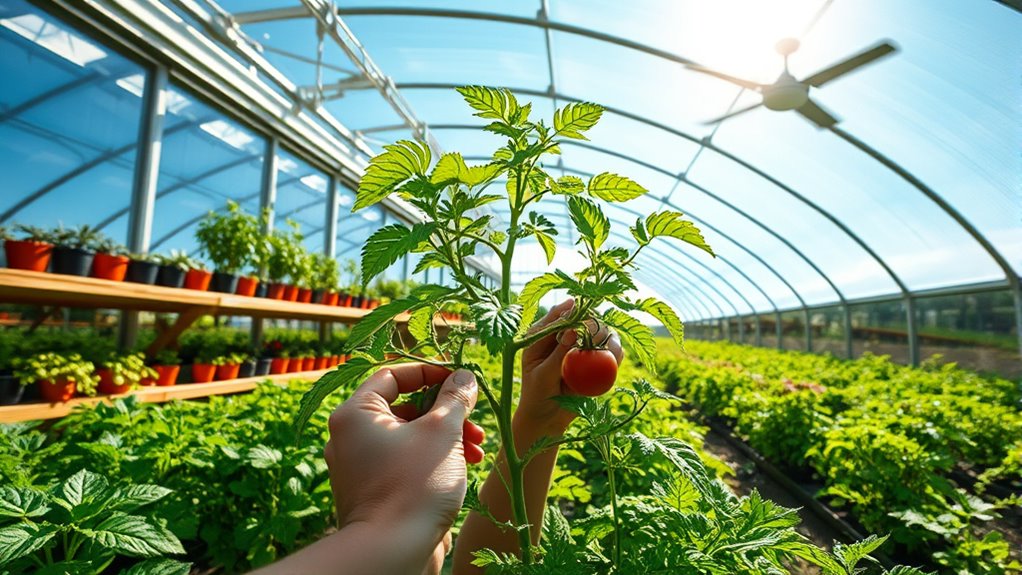Upgrading your greenhouse is all about enhancing aesthetics and functionality. Paint doors in bright colors, use tiered plant shelves, and add stylish shade cloth for flair. Consider energy-efficient LED lights and insulation for peak growth. Explore DIY options like recycled window greenhouses or portable designs. Mix plant species to boost productivity and implement regular maintenance checks for efficiency. These upgrades will transform your space into a thriving garden haven. Discover even more tips for an amazing greenhouse experience.
Key Takeaways
- Enhance aesthetics by incorporating bright colors, tiered shelving, and stylish accessories like throw blankets and vintage items.
- Upgrade to energy-efficient LED grow lights and smart grids for improved energy management and sustainability.
- Explore DIY greenhouse designs such as recycled windows or portable mini greenhouses to suit your space and budget.
- Increase productivity by mixing diverse plant species and implementing vertical gardening techniques for optimal space usage.
- Conduct regular maintenance checks, including climate control calibration and irrigation inspections, to ensure optimal growing conditions.
Enhancing Aesthetics With Decor
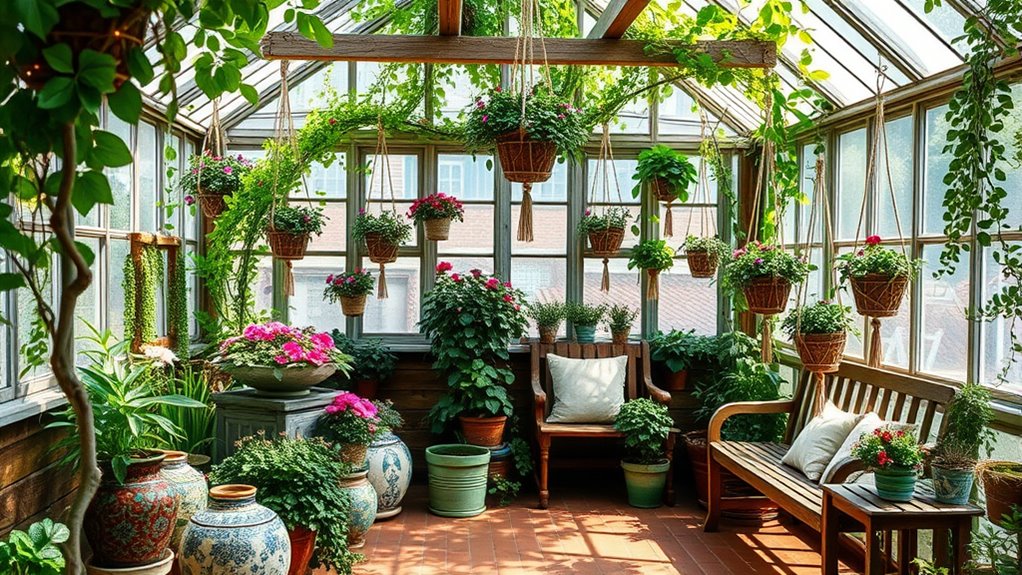
When you want to elevate the aesthetics of your greenhouse, consider how decor can transform the space into a vibrant oasis. Bright colors can make a huge difference—paint doors in lively shades like yellow or choose colorful planters to enhance visual appeal. Incorporating tiered plant shelving adds dimension and interest, while stylish shade cloth not only protects your plants but also adds flair. Additionally, daisy varieties like Shasta and Gerbera can be used to bring bright colors into your greenhouse. Don't forget about accents; throw blankets and pillows can keep the atmosphere lively.
To create a welcoming environment, ensure that the layout promotes ease of movement for all, especially seniors who may need additional support. For a unique touch, add hanging planters, statement furniture, and vintage accessories. To create a personalized environment, consider using repurposed materials that reflect your style and contribute to sustainability. Finally, string lights or mirrors can create a magical ambiance, making your greenhouse not just functional, but a beautiful retreat you'll love spending time in. To make the greenhouse more accessible for the elderly, consider incorporating elderly care solutions that ensure safety and ease of movement within the space.
Improving Functionality for Optimal Growth
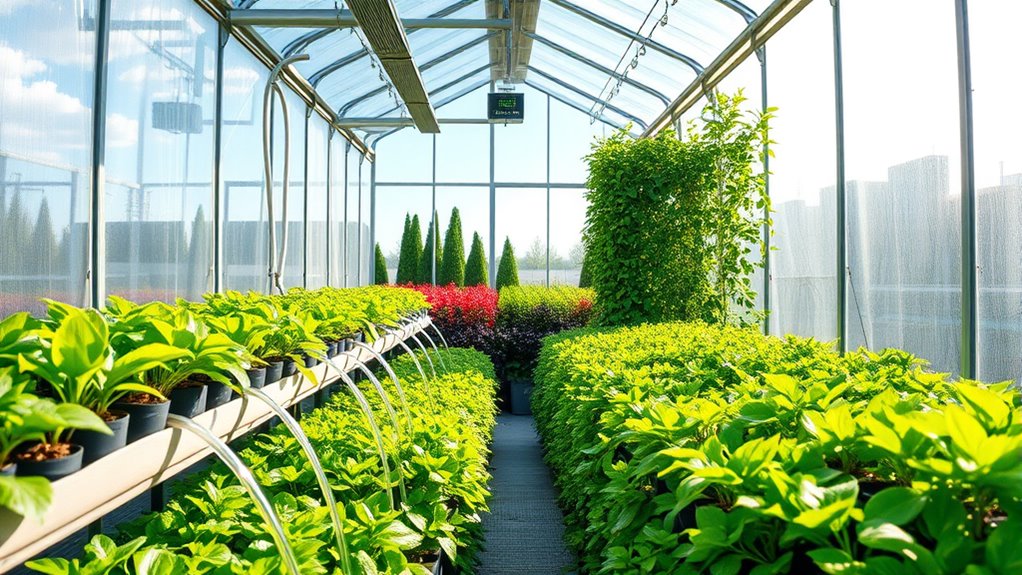
To achieve ideal growth in your greenhouse, focusing on functionality is essential.
Start by upgrading your lighting to energy-efficient LED grow lights, which can cut electricity costs considerably. Insulate your greenhouse to minimize heat loss and maintain consistent temperatures, and consider using thermal screens for added energy efficiency. Implementing smart grids can also enhance energy management and sustainability in your greenhouse. Additionally, utilizing solar energy can significantly reduce operational costs and improve environmental sustainability. Creating a mindful environment enhances the overall growth experience for both plants and gardeners alike.
Invest in advanced control systems for better environmental management, and utilize automated ventilation to enhance air circulation. Regular energy audits will help identify inefficiencies, while implementing high-efficiency fans and sealing gaps around them will further enhance airflow.
Finally, schedule regular maintenance for your equipment to keep everything running smoothly. By making these improvements, you'll create an environment that promotes ideal plant growth. Additionally, consider incorporating backyard greenhouse features that cater to your specific gardening needs and climate for even better results.
Exploring DIY Greenhouse Options
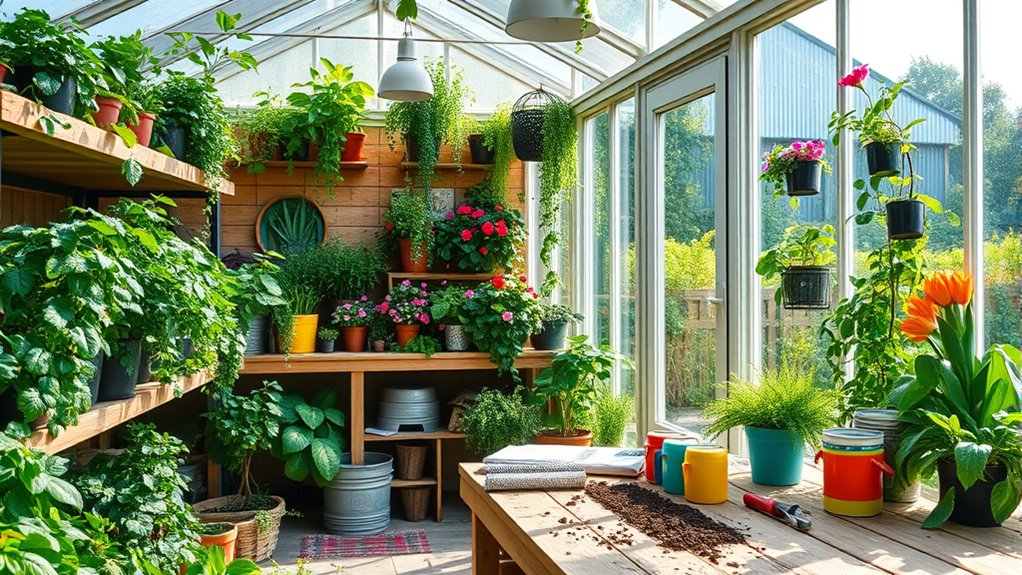
Exploring DIY greenhouse options opens up a world of creativity and practicality for gardeners of all levels.
Discover the endless possibilities of DIY greenhouses, perfect for every gardener looking to blend creativity with practicality.
You can choose from various designs, like the lightweight GeoDome or the rustic wooden greenhouse that adds charm to your garden. If you're on a budget, consider a recycled window greenhouse or an arched PVC structure, both easy to assemble and eco-friendly.
For smaller spaces, a portable mini greenhouse works perfectly. When planning your build, think about using durable materials like treated lumber or bamboo for sustainability. Additionally, integrating self-watering planters into your greenhouse can simplify maintenance and promote healthy plant growth.
Whichever option you pick, make certain you level the site, construct a solid frame, and add proper ventilation for peak plant health. Embrace your DIY journey and enjoy growing your plants in style!
Increasing Productivity With Plant Diversity
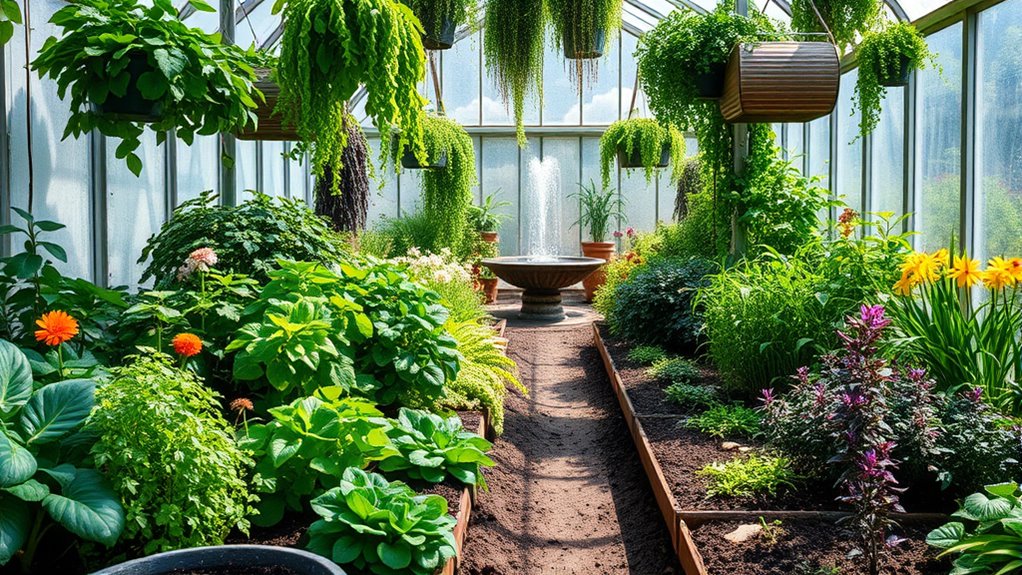
Integrating plant diversity into your greenhouse can greatly boost your productivity and overall plant health. By mixing different species, you can increase yields by 15.2% compared to monocultures.
Diverse plants improve productivity through complementarity effects, where niche partitioning enhances growth and stability. Adding nitrogen-fixing plants alongside others can further elevate your output.
Additionally, diverse communities reduce soil pathogens and pest pressure, minimizing the need for pesticides. To implement this, select a variety of heat-tolerant crops, optimize your layout with vertical gardening, and manage climate controls effectively.
Implementing Efficient Maintenance Practices

While maintaining your greenhouse might seem like a challenging task, implementing efficient practices can greatly enhance its longevity and productivity.
Start with regular inspections; daily observations help you spot potential issues early. Check for cracks in glazing materials and guarantee your ventilation systems work correctly to maintain a healthy environment.
Don't forget to calibrate your climate control sensors and install energy-efficient lighting that adjusts with natural sunlight.
Inspect your irrigation lines to prevent clogging, and consider upgrading to advanced systems for better water management.
Finally, conduct energy audits to identify areas for improvement.
Creating Comfortable and Inviting Spaces
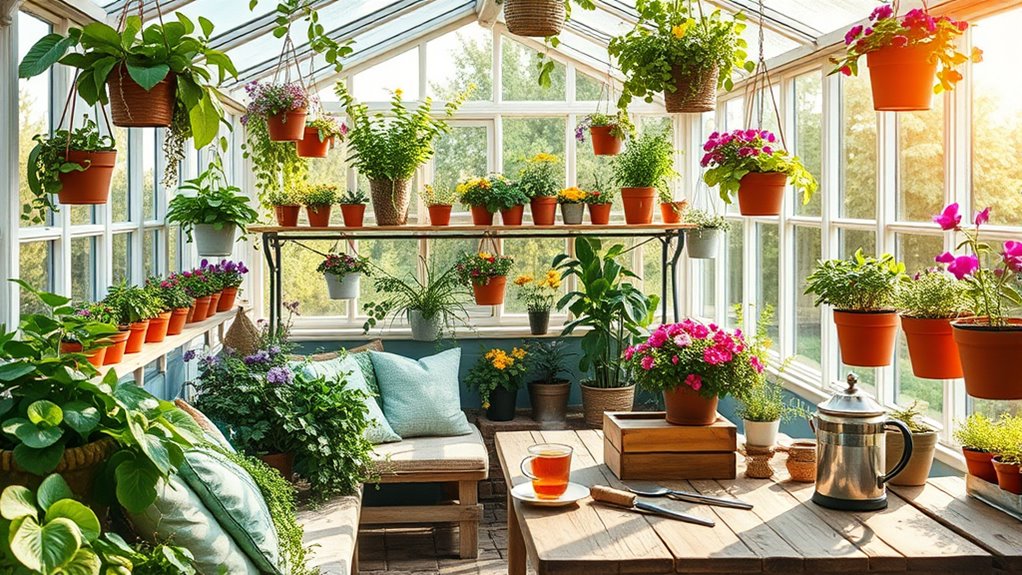
Creating a comfortable and inviting greenhouse space not only enhances your gardening experience but also makes it a delightful retreat.
Start by adding a cozy chair or bench where you can relax amidst your plants. Bright cushions and blankets will soften the space and distract from clutter. For a warm ambiance, use solar-powered lights to create a soft evening glow.
Incorporating natural materials like wood and rattan for furniture adds to the inviting feel. Arrange colorful plants and tiered shelving for visual interest. Additionally, consider selecting non-toxic houseplants that are safe for pets to ensure a worry-free environment.
Finally, consider adding personal touches, like decorative macrame holders or upcycled planters, to reflect your style. With these elements, your greenhouse can become a serene haven that inspires creativity and tranquility.
Maximizing Storage and Organization
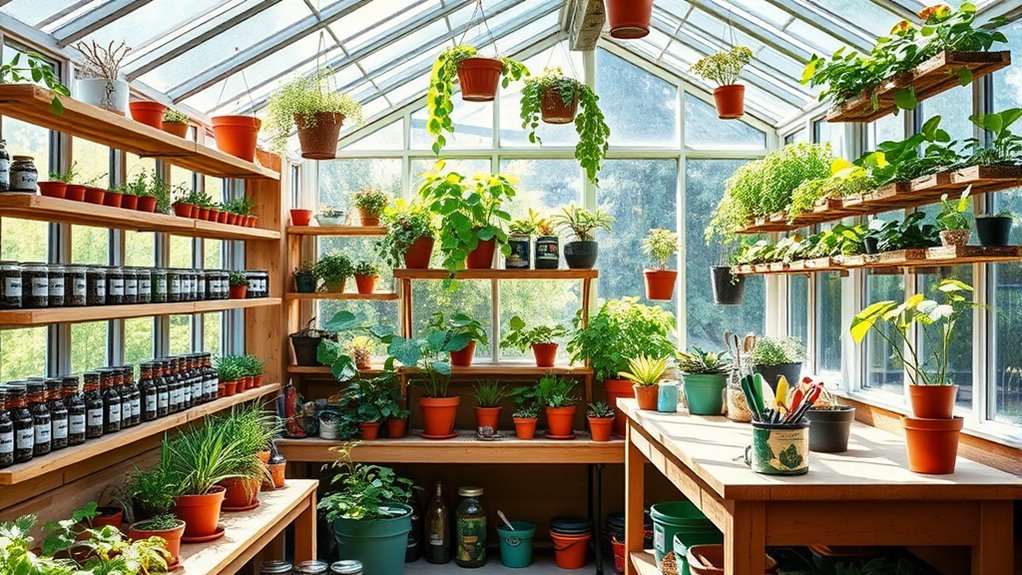
A well-organized greenhouse is just as important as a comfortable one, as it directly impacts your gardening efficiency.
To maximize storage, utilize vertical space with grow towers and hanging baskets for your favorite herbs and vegetables. Consider installing adjustable shelves and planter walls to keep your plants thriving without crowding.
Maximize your greenhouse storage by using vertical space with grow towers and hanging baskets for herbs and vegetables.
Implement zoning strategies by dividing your space into areas for potting and storage, grouping similar plants together for easier care. Enhance storage solutions with durable, moisture-resistant shelving and clear containers for visibility.
Don't forget to repurpose old furniture and create multi-functional items like potting benches. Regularly clean and maintain clear pathways to keep your greenhouse efficient and productive, adapting as needed for seasonal changes.
Frequently Asked Questions
What Are the Best Plants for Low-Light Greenhouses?
If you're looking for the best plants for low-light greenhouses, consider shade-tolerant herbs like mint and chives.
Leafy greens such as spinach and kale also thrive in these conditions.
For flowering options, try African Violets or Impatiens to add color.
Foliage plants like Peace Lilies and ZZ Plants are great for their low-maintenance nature.
These choices will help you create a vibrant and productive environment in your low-light greenhouse.
How Can I Prevent Pests Naturally in My Greenhouse?
To prevent pests naturally in your greenhouse, start by keeping it clean and removing any plant debris.
Regularly inspect your plants, especially the undersides of leaves, for early signs of pests. You can introduce beneficial insects like ladybugs and use insecticidal soaps or garlic sprays to repel unwanted visitors.
Installing fine-mesh screens on vents helps keep pests out, while promoting biodiversity encourages natural pest control.
Regular maintenance and vigilance are key!
What Temperature Should I Maintain for Tropical Plants?
To keep your tropical plants happy, think of it as providing them a warm hug.
You should maintain daytime temperatures between 22°C and 28°C and guarantee nighttime temperatures stay above 18°C. Avoid drastic temperature changes, as they can stress your plants.
Focus on managing heat and humidity, aiming for humidity levels above 80%.
How Often Should I Water Plants in the Greenhouse?
You should water your greenhouse plants based on their specific needs.
Generally, water daily or every other day during warmer months, while reducing frequency in cooler seasons.
Monitor soil moisture regularly; if the top inch feels dry, it's time to water.
Use techniques like drip irrigation for efficiency and always guarantee pots have drainage holes to prevent overwatering.
Adjust your schedule as environmental conditions change to keep your plants thriving.
What Materials Are Best for Greenhouse Construction?
When it comes to greenhouse construction, you'll want the best materials to transform your space into a plant paradise!
Think about sturdy wood for charm, or lightweight PVC for easy assembly. If durability's your game, aluminum's got you covered.
For covering, glass shines bright, while polycarbonate's a superhero with its insulation powers.
Don't forget a solid concrete foundation to keep everything grounded.
With these materials, your greenhouse will thrive like never before!
Conclusion
As you upgrade your greenhouse, think of it as nurturing a budding flower. Each improvement, from vibrant decor to efficient storage, contributes to a flourishing ecosystem. By embracing diversity in plant life and creating inviting spaces, you're not just cultivating plants; you're cultivating joy and productivity. Remember, a well-tended greenhouse is a reflection of your care and creativity. Just like a flower blooming, your efforts will blossom into a thriving sanctuary for growth and inspiration.
